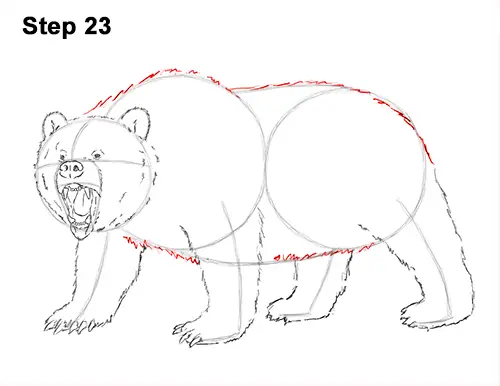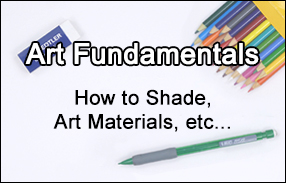
Step 20: Use the line on the far left side as a guide to draw the grizzly bear's other front leg the same way. Follow the path of the guide and draw the shape of the leg around it using quick, short strokes. Curve the end of the shape to the left to create the foot and add the five claws at the tip. Each claw is made up of a small, curved triangle-like shape along the bottom edge of the foot.

Step 21: Now use the line on the far right side as a guide to draw the grizzly bear's first hind leg. Remember to use quick, short strokes to draw the leg, and to make the top wide and the bottom narrow. Add the claws at the top on the left, but only four of the five should be visible from this angle.

Step 22: Use the last line as a guide to draw the grizzly bear's other hind leg. The top part of the leg will be behind the body, so don't worry about drawing that section.

Step 23: Use the remaining lines as guides to draw the rest of the grizzly bear's body. Simply darken the outer edges of the initial guides to create the shape of the body. Use quick, short strokes as you follow the guides to create a fur-like texture.

Step 24: For a cleaner look, erase as much as you can of the initial guide lines. Don't worry about erasing all of the guides. It's okay to leave some behind. Re-draw any final sketch lines you may have accidentally erased.

Final Step: Add some shading to your grizzly bear drawing to give it more dimension and volume. Pick the direction of the light source when shading so that the shadows are consistent with it. Vary the pressure on your pencil to get different degrees of tonal value. As you add the shadows, use strokes that go in the general direction of the fur.
Add a cast shadow underneath. This helps ground the bear so it doesn't appear to be floating.
You can add even more value throughout your drawing for extra detail. Grizzly bears don't have any kind of pattern on their coats, so just use a medium value throughout the body. Use shorter stokes when you add the value to the head as opposed to the longer strokes you will use for the body. As you shade the head, use strokes that radiate outward from the nose. Darken the shadows as you add the value for the coat to emphasize the form.
Don't worry about shading too smoothly. The rough value gives the coat a furry texture. The strokes within the body should have a horizontal orientation, while on the legs the strokes should mainly be vertical. Shading can be time-consuming, so be patient and take breaks. Continue adding the value until the entire body is covered in a fur-like texture. It's always a good idea to use reference as you draw. Don't forget to pause the video to draw at your own pace.
Thanks for watching! Subscribe to the How2DrawAnimals YouTube Channel for a new tutorial every Tuesday.
To learn how to draw popular cartoon characters, visit EasyDrawingTutorials.com.
RELATED TUTORIALS
 |
 |
 |







